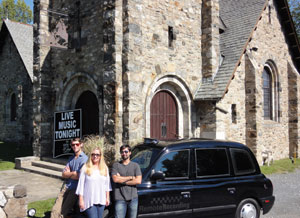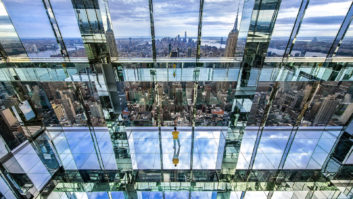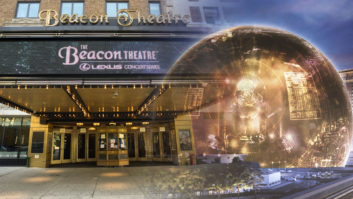
Engineer Fernando Lodiero, Remote Recording owner Karen Brinton, and engineer Matt Scheiner outside The Winery at St. George, where they recorded the 101st anniversary show.
It was quite visible at the October 2013 AES convention in New York. Right outside the front door, Karen Brinton parked her newest addition to the Remote Recording family and opened the doors to anybody who was curious. “Is it a PT Cruiser?” some asked, admiring the sleek black finish with the tall, wide-body profile. “Actually, it’s a London Taxi,” Brinton would respond. “Do you want to climb inside?”
Then the audio geeks took over as visitors gushed over the ergonomics inside. Pro Tools HDX system, two Avid/Euphonix MC controllers, an SPL Neon analog board, a 500 Series rack, ADAM A3X monitoring, and two flip–down seats facing the rear.
“The footprint is fantastic, especially in a major urban market like New York, where mobility is important,” says Karen Brinton, who purchased Remote Recording in 2003. “Two tall guys can sit in the back of the taxi and work very comfortably. All of the connectivity comes out of the boot. Pro Tools rides shotgun. And it works!”
The remote recording industry has been hit every bit as hard as the studio industry in recent years, with fewer large gigs, shrinking budgets, and a move toward no-cost, laptop-based recording. After seeing the famed Silver Truck sit for months on end, Brinton started looking for a solution that would sit somewhere between a laptop/flypack and the big-time broadcast event.
“The days of audio-only recording are pretty much extinct, except on the very high end,” Brinton says. “Budgets are continuing to shrink, and this is our way to enter the $5,000 and under show. It’s cost-efficient and practical, and we no longer have to turn down a club gig where the truck won’t fit. It’s the pro-quality sound that they expect from Remote Recording, just in a smaller package.”
For the uninitiated, the London Taxi Company is its own manufacturer, producing about 1,800 vehicles a year in the distinctive “black cab” style, primarily for the London streets. Brinton found hers on eBay, in Phoenix, soon after she talked with a few London associates and settled on her concept. Her father checked it out, her brother found a local mechanic, and soon the cab was shipped to Europe, where it was spiffed up and wired, according to drawn-up plans, but still needed the equipment installed. She called Matt Scheiner, son of Elliot Scheiner, whom she had known as a kid but now hired as an engineer on live gigs. Would he be interested in outfitting and operating?
“How could I pass that up?” Scheiner laughs. “It’s so cool to drive around!” A May 2006 Berklee graduate, Scheiner has already spent a lifetime in audio, recalling the days as a baby when he once threw up on a Neve 8058 console at Ocean Way while “assisting” his dad. “Recording was my destiny from then on,” he says.
A guitar player, touring musician, multi-instrumentalist, FOH and studio engineer, and sometime producer, Scheiner started about a year ago reading the schematics and modifying the layout. He learned video sync necessities and stage and power requirements. “With a lot of help from some very smart people,” he says, he got the Taxi ready by summer 2012. All they need is AC from the venue, which powers a UPS battery system, which runs the gear. Run a fiber cable, hook up the stage boxes, and they’re good to go. Today, Scheiner is the Taxi’s main mixer, along with Fernando Lodiero.
Though passersby tend to look at it curiously, its non-obtrusiveness is actually a benefit. “It’s stealth, quite honestly,” Brinton says. “People don’t see us and think, ‘What are they shooting there?’ They think it’s a taxi. It’s very easy to get in and get out without bothering anybody.”
That low-profile proved valuable in a very different way for one of the Taxi’s more meaningful gigs to date: Recording the Sandy Hook children’s choir in December 2012, less than a month after the tragedy, singing “America the Beautiful” for the Super Bowl pregame show.
“Instead of pulling these children into a studio, another foreign environment, we brought the studio to them,” Brinton recalls. “Matt and I brought the Taxi in. We parked at the back of the school and ran the cables up. They’re in their music room, where they’re used to singing and playing, and we spent probably four hours with these kids. You could tell they had all been through hell, so Matt and I just wanted to make it as comfortable as possible. Bring them down to see the Taxi. It was one of the most meaningful days of my life. When they sang at the Super Bowl, I started crying. I got to be part of that.”
“I’m sure it would have been a lot less personable to bring in a truck,” Scheiner adds. “This little Taxi, parked in back, the kids loved it.” Today the Taxi can handle a three-camera video shoot and broadcast capability is coming soon. Brinton’s dream is to establish a fleet across major U.S. markets, handling everything from house of worship to theater to clubs to choirs. But she knows it has to be affordable.
“Sound is like wine,” Brinton concludes. “It doesn’t have to be expensive to be good.”



